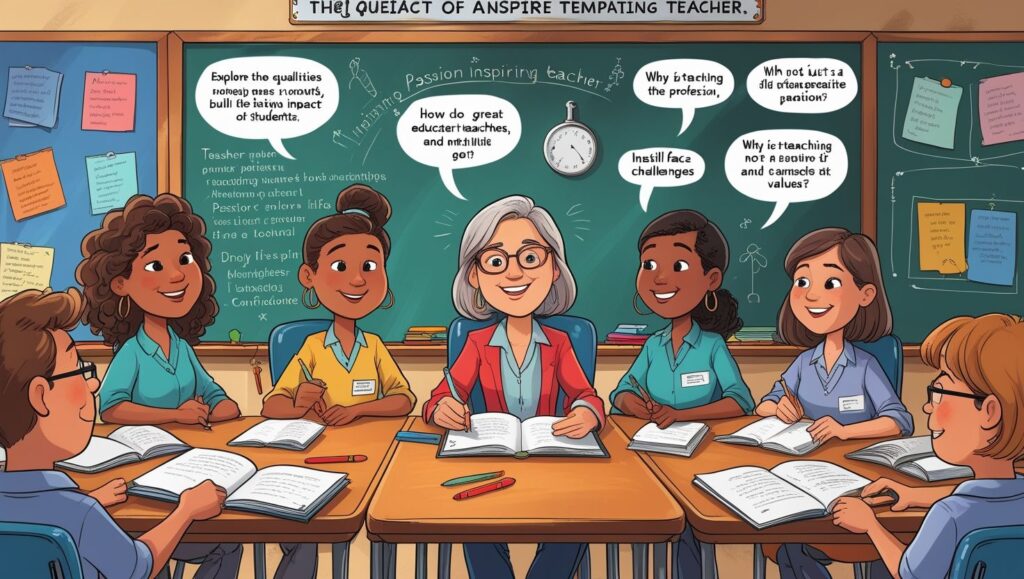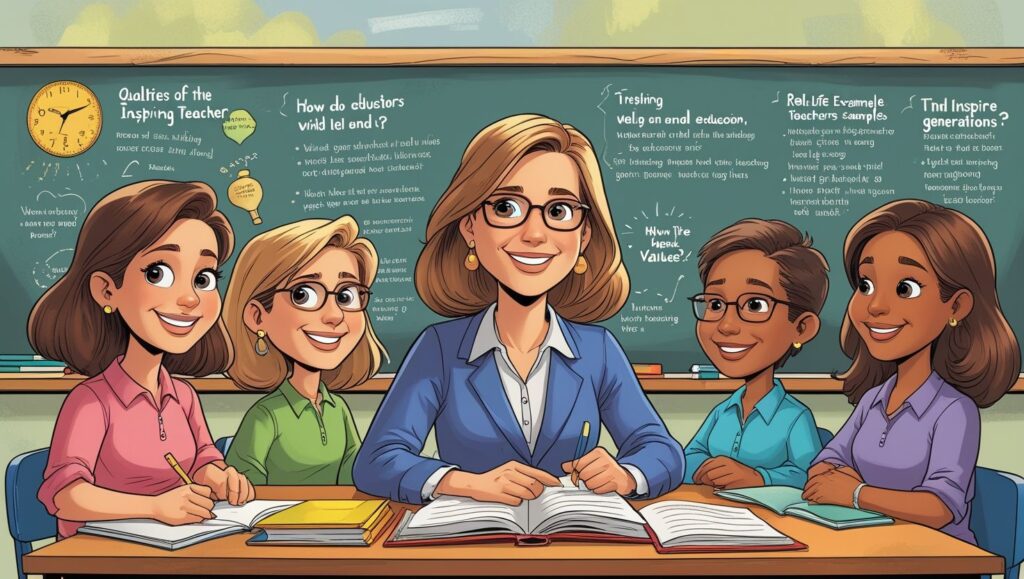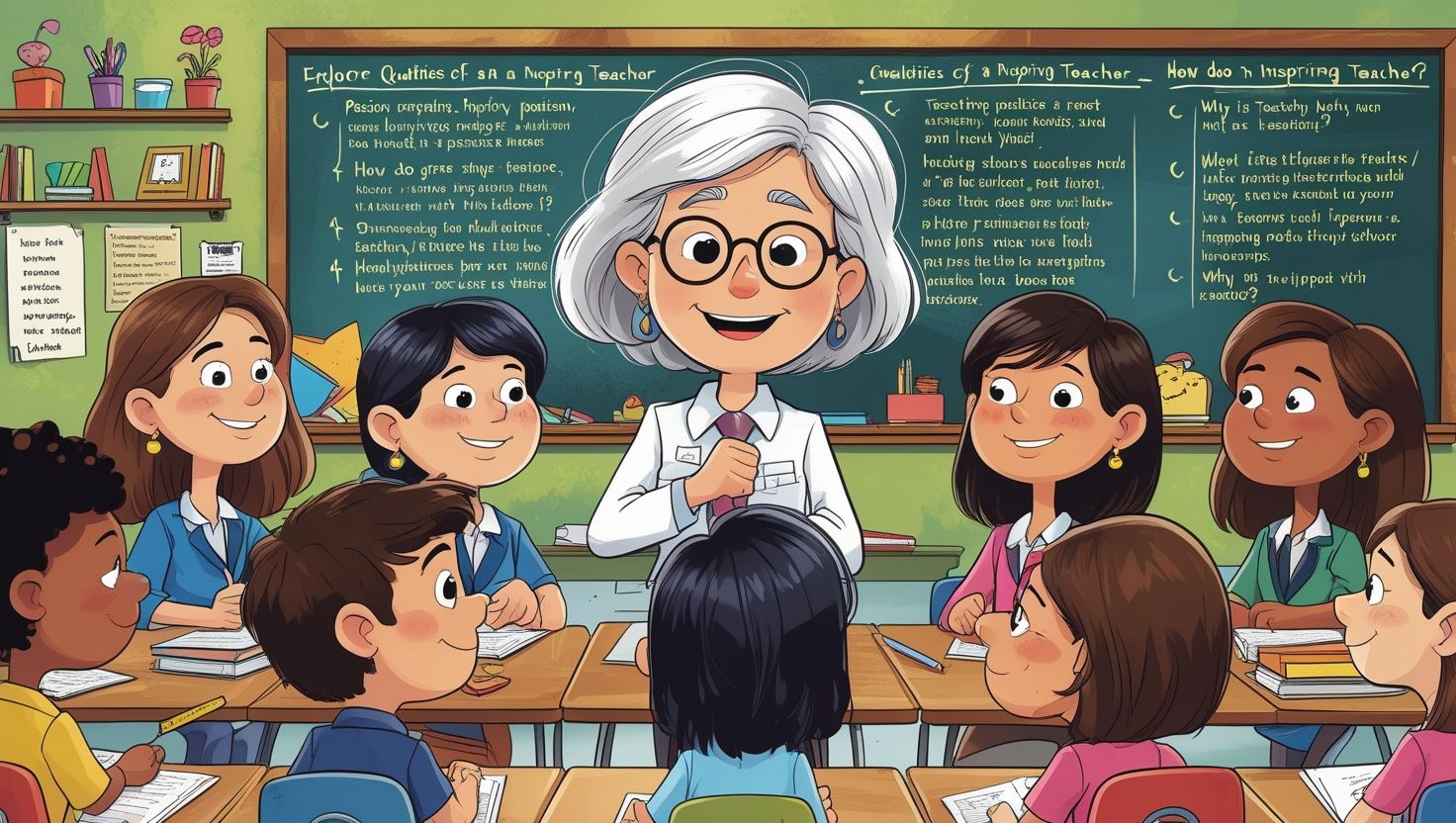Introduction
The Inspiring Teacher: Shaping Minds, Touching Hearts, Teachers hold one of the most noble and influential roles in society. They are not just educators but mentors, guides, and often, lifelong inspirations. An inspiring teacher does more than impart knowledge—they ignite curiosity, instill values, and shape character. In a world where education is rapidly evolving, the role of a teacher remains timeless: to nurture minds and prepare future generations for the challenges ahead.
This article explores the qualities of an inspiring teacher, their impact on students, and how they contribute to society. Through real-life examples, psychological insights, and reflections on teaching methodologies, we will understand what makes a teacher truly exceptional.
1. Qualities of an Inspiring Teacher
What sets an inspiring teacher apart from others? While subject expertise is essential, great teachers possess a combination of personal and professional traits that leave a lasting impression on their students.
a) Passion for Teaching
An inspiring teacher genuinely loves what they do. Their enthusiasm for the subject is contagious, making even the most complex topics engaging. Passion drives them to go beyond textbooks, using creative methods to make learning enjoyable.
b) Empathy and Understanding
Great teachers recognize that every student is unique. They listen, show compassion, and adapt their teaching style to meet individual needs. This emotional connection fosters trust and encourages students to perform better.
c) Patience and Perseverance
Learning is a journey with ups and downs. Inspiring teachers remain patient, offering extra help to struggling students without frustration. They believe in their students’ potential, even when the students themselves doubt it.
d) Strong Communication Skills
Effective teaching requires clear and engaging communication. Inspiring teachers explain concepts in simple, relatable ways and encourage open discussions. They also listen actively, making students feel valued.
e) Lifelong Learning
The best teachers never stop learning. They stay updated with new teaching methods, technology, and advancements in their field. This growth mindset inspires students to embrace continuous self-improvement.
f) Leadership and Role Modeling
Teachers are natural leaders. Their behavior, ethics, and dedication set an example for students. An inspiring teacher leads by actions, not just words, demonstrating integrity, discipline, and kindness.

2. The Impact of an Inspiring Teacher
The influence of a great teacher extends far beyond the classroom. Their words and actions can shape a student’s future, career choices, and even personality.
a) Academic Success
Students taught by passionate teachers often perform better academically. When learning is engaging, students retain information longer and develop critical thinking skills.
b) Boosting Confidence
Many students struggle with self-doubt. An inspiring teacher recognizes their strengths, encourages them, and helps them overcome challenges. This confidence stays with them for life.
c) Instilling Moral Values
Beyond academics, teachers shape character. Through their conduct and discussions, they instill values like honesty, respect, and perseverance.
d) Inspiring Career Paths
Some of the world’s greatest scientists, writers, and leaders credit their success to a teacher who believed in them. A single encouraging word can ignite a lifelong passion.
e) Emotional and Psychological Support
For many students, teachers are a source of emotional support, especially those facing difficulties at home. A caring teacher can be a lifeline, offering guidance and stability.
3. Real-Life Examples of Inspiring Teachers
History is filled with teachers who changed lives through their dedication. Here are a few remarkable examples:
a) Anne Sullivan – Helen Keller’s Teacher
Anne Sullivan, despite being visually impaired herself, taught Helen Keller, a deaf-blind child, to communicate. Through patience and innovative methods, she unlocked Keller’s potential, who later became a renowned author and activist.
b) Jaime Escalante – The Math Motivator
A Bolivian-American teacher, Escalante famously taught calculus to underprivileged students in Los Angeles. His belief in his students led them to achieve exceptional results, proving that with hard work and encouragement, any obstacle can be overcome.
c) Dr. APJ Abdul Kalam – The People’s President and Teacher
Before becoming India’s President, Dr. Kalam was a beloved professor. He inspired countless students with his humility, wisdom, and vision for education. His teachings continue to motivate young minds.
d) Marva Collins – Champion of Underprivileged Students
Marva Collins founded a school in Chicago for children labeled as “unteachable.” Through her relentless dedication, she proved that every child can excel with the right guidance.
4. Challenges Faced by Teachers Today
Despite their crucial role, teachers face numerous challenges:
- Overcrowded Classrooms – Large student numbers make personalized attention difficult.
- Limited Resources – Many schools lack proper teaching tools and technology.
- Parental and Societal Pressure – High expectations and criticism can be demoralizing.
- Emotional Burnout – Teaching is emotionally demanding, often leading to stress.
- Adapting to Technology – The shift to digital learning requires continuous upskilling.
Despite these obstacles, inspiring teachers persevere, driven by their commitment to their students.
5. How to Become an Inspiring Teacher
Becoming an inspiring teacher is not just about mastering a subject—it’s about transforming lives. Great educators leave a lasting impact by fostering curiosity, building confidence, and shaping character. Below is an in-depth exploration of the key strategies that help teachers inspire their students.
a) Build Strong Relationships
Why Relationships Matter
Students learn best when they feel valued and understood. A strong teacher-student relationship creates a safe, supportive environment where students are more willing to take risks, ask questions, and engage deeply with the material.
How to Build Strong Relationships
- Learn Students’ Names Quickly – Using a student’s name shows respect and helps establish a personal connection.
- Understand Their Backgrounds – Knowing their cultural, social, and family context helps tailor teaching approaches.
- Identify Strengths and Weaknesses – Some students excel in creativity but struggle with structure; others may be analytical but shy in discussions. Adjust teaching methods accordingly.
- Show Genuine Interest – Ask about their hobbies, goals, and challenges outside academics.
- Be Approachable – Encourage students to ask questions without fear of judgment.
Impact on Students
- Increased participation and engagement
- Greater confidence in academic abilities
- Improved behavior and classroom discipline

b) Make Learning Interactive
Why Interaction is Key
Passive learning (lectures, note-taking) often leads to disengagement. Interactive teaching keeps students mentally active, improving retention and understanding.
Methods to Make Learning Interactive
- Storytelling – Relate lessons to real-life stories, historical events, or personal experiences.
- Debates & Discussions – Encourage students to express opinions, defend viewpoints, and listen to others.
- Hands-on Experiments – Science, math, and even literature can be taught through experiments, role-plays, and projects.
- Technology Integration – Use educational apps, videos, and gamified quizzes (e.g., Kahoot!, Quizlet).
- Group Activities – Collaborative learning fosters teamwork and problem-solving skills.
Impact on Students
- Higher motivation and enthusiasm
- Better retention of information
- Development of communication and teamwork skills
c) Encourage Critical Thinking
Why Critical Thinking is Essential
Memorization alone does not prepare students for real-world challenges. Critical thinking helps them analyze, question, and apply knowledge creatively.
How to Foster Critical Thinking
- Ask Open-Ended Questions – Instead of “What is the capital of France?” ask, “Why do you think Paris became France’s capital?”
- Encourage Debate – Present controversial topics and let students argue different perspectives.
- Problem-Based Learning – Give real-world problems to solve (e.g., “How can we reduce plastic waste in school?”).
- Teach Logical Reasoning – Use puzzles, riddles, and case studies to develop analytical skills.
- Promote Reflection – After lessons, ask, “What did you learn? How can you apply this?”
Impact on Students
- Enhanced problem-solving abilities
- Greater independence in learning
- Preparation for higher education and careers
d) Provide Constructive Feedback
Why Feedback Matters
Feedback shapes improvement. Harsh criticism discourages, while vague praise doesn’t help. Constructive feedback guides students toward growth.
How to Give Effective Feedback
- Be Specific – Instead of “Good job,” say, “Your essay had strong arguments, but adding more examples would make it even better.”
- Focus on Effort, Not Just Results – Praise persistence: “I see you worked hard on this project—keep it up!”
- Use the “Sandwich Method” – Start with praise, then suggest improvements, and end positively.
- Encourage Self-Assessment – Ask, “What do you think went well? What could you improve?”
- Follow Up – Check later to see if they’ve applied feedback.
Impact on Students
- Increased self-awareness and growth mindset
- Reduced fear of failure
- Stronger motivation to improve
e) Stay Inspired
Why Teacher Inspiration Matters
A motivated teacher inspires motivated students. Burnout is common in education, so staying inspired is crucial for long-term success.
How to Stay Inspired
- Continuous Learning – Attend workshops, webinars, and courses on new teaching methods.
- Read Educational Books – Explore works by great educators (e.g., Teach Like a Pirate by Dave Burgess).
- Network with Fellow Teachers – Share ideas, challenges, and successes with colleagues.
- Reflect on Your Purpose – Remind yourself why you chose teaching. Student success stories can reignite passion.
- Practice Self-Care – Avoid burnout by setting boundaries, taking breaks, and pursuing hobbies.
Impact on Teaching
- Renewed enthusiasm in the classroom
- Innovative teaching approaches
- Long-term career satisfaction
6. The Legacy of an Inspiring Teacher
Great teachers leave behind a legacy that transcends time. Their students carry forward their lessons, values, and inspiration. Some become teachers themselves, continuing the cycle of knowledge and mentorship.
In a world that often measures success in wealth and fame, teachers remind us that true impact lies in shaping minds and hearts.
Conclusion
An inspiring teacher is a beacon of hope, a catalyst for change, and a lifelong mentor. Their influence shapes not just individuals but entire communities and future generations. While the challenges of modern education are many, the rewards of teaching—seeing a student’s eyes light up with understanding, watching them succeed, and knowing you played a part—are immeasurable.
To all the teachers who dedicate their lives to this noble profession: Thank You. Your work is the foundation of progress, and your impact is eternal.

